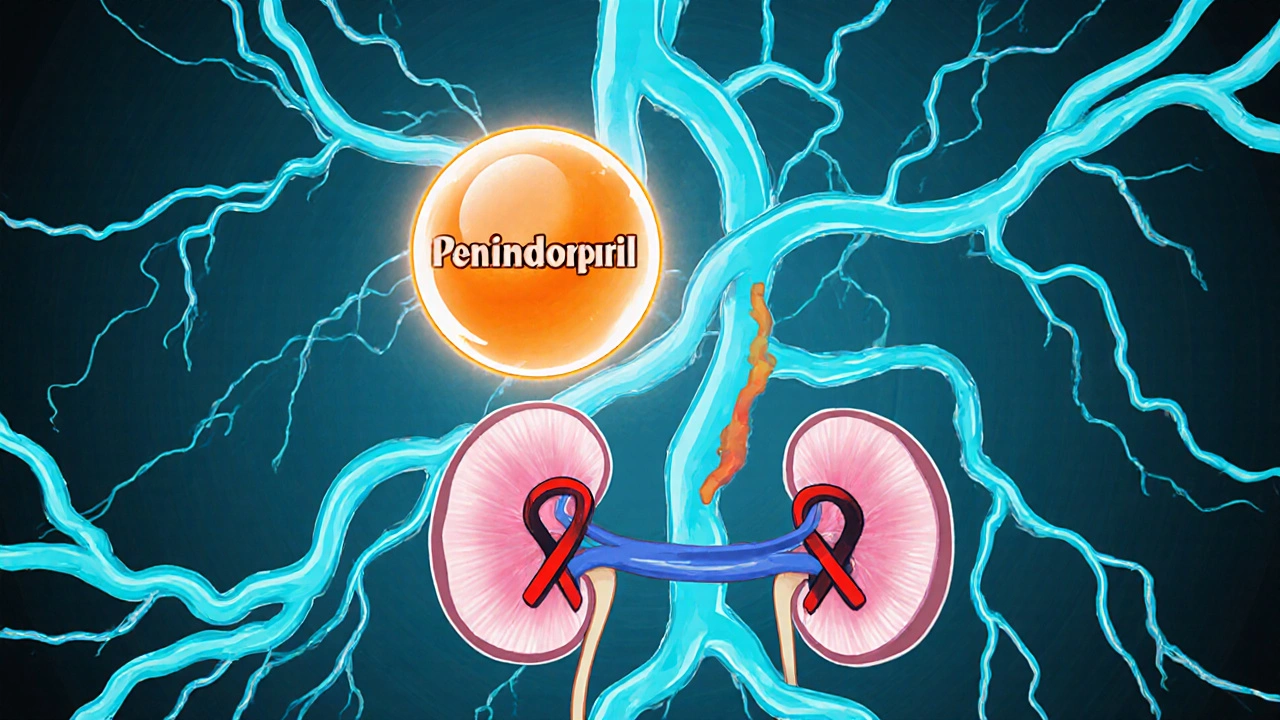Perindopril Erbumine Dosing Calculator for Elderly
Age Factor: Patients over 65 need lower starting doses.
Kidney Function: eGFR below 60 mL/min requires dose reduction.
Side Effect Risk: Cough, dizziness, and hyperkalemia are common.
Monitoring: Check blood pressure and kidney function regularly.
Recommended Dose
Key Side Effects to Monitor
- Dry cough (12-15% incidence)
- Dizziness/orthostatic hypotension (8-10%)
- Hyperkalemia (4-6%)
- Renal function decline (2-3%)
Quick Summary
- Perindopril erbumine is an ACE inhibitor that works well for high blood pressure but needs careful dosing in people over 65.
- Age‑related changes in kidney function, body water, and drug metabolism often mean a lower starting dose and slower titration.
- Watch for cough, dizziness, and low potassium - these are the most common side effects in older adults.
- Drug interactions with diuretics, NSAIDs, and potassium‑rich supplements are frequent sources of trouble.
- Regular blood‑pressure checks, kidney‑function tests, and a clear communication plan with caregivers can keep risks low.
When treating older patients, Perindopril Erbumine is an angiotensin‑converting enzyme (ACE) inhibitor used to lower blood pressure and reduce cardiovascular risk. It’s a favorite in many guidelines because it lowers systolic pressure without causing a rapid heart‑rate drop. But the “one‑size‑fits‑all” mindset can be dangerous once you’re dealing with people over 65. Their bodies handle drugs differently, and the same dose that works for a 45‑year‑old can tip a senior into dizziness, falls, or kidney trouble. This guide walks you through what makes older adults unique, how to adjust the dose, which side effects matter most, and practical steps for patients, caregivers, and clinicians alike.
How Perindopril Erbumine Works
Perindopril belongs to the ACE inhibitor family. It blocks the enzyme that converts angiotensin I to angiotensin II, a powerful vessel‑constricting hormone. With less angiotensin II, arteries relax, blood pressure drops, and the heart doesn’t have to pump as hard. The drug also reduces aldosterone release, which helps prevent fluid overload - a big win for people with heart failure.
Key attributes of Perindopril Erbumine:
- Bioavailability: About 70 % of the oral dose reaches the bloodstream as the active form.
- Half‑life: 3‑5 hours for the parent compound, but its metabolite perindoprilat stays active for 12‑15 hours, allowing once‑daily dosing.
- Elimination: Primarily renal; about 60 % is cleared unchanged in the urine.
Why Seniors Need Special Attention
Age brings three physiological shifts that directly affect Perindopril:
- Reduced renal clearance: Glomerular filtration rate (GFR) drops about 1 mL/min per year after age 40. Lower GFR means the active metabolite stays longer, raising the risk of hypotension and hyperkalemia.
- Altered body composition: Less total body water and more fat mean drug distribution changes. Perindopril, being water‑soluble, stays more concentrated in the plasma of an older adult.
- Polypharmacy: Seniors often take five or more medicines, increasing the chance of harmful drug‑drug interactions.
Because of these factors, most clinicians start at half the adult dose and monitor closely.
Dosage Guidelines for Older Adults
The usual adult starting dose for hypertension is 4 mg once daily, titrated up to 8 mg or 16 mg as needed. For most patients over 65, the recommended approach is:
- Initial dose: 2 mg once daily.
- First titration (after 2‑4 weeks): Increase to 4 mg if blood pressure remains above target and the patient tolerates the drug well.
- Maximum dose: 8 mg daily for most seniors; some may go to 12 mg under specialist supervision.
When kidney function is impaired (eGFR < 30 mL/min/1.73 m²), a lower ceiling of 4 mg is advised. The table below summarizes the adjustments.
| eGFR (mL/min/1.73 m²) | Starting Dose | Max Recommended Dose |
|---|---|---|
| ≥ 60 | 2 mg once daily | 8 mg daily |
| 30 - 59 | 2 mg once daily | 6 mg daily |
| 15 - 29 | 1 mg once daily | 4 mg daily |
| < 15 | 1 mg once daily (or consider alternative) | 4 mg daily (with close monitoring) |
Always pair dosage changes with blood‑pressure checks and repeat serum potassium and creatinine labs within 1‑2 weeks of each adjustment.

Kidney Function, Electrolytes, and Monitoring
Because Perindopril is cleared by the kidneys, seniors should have baseline and follow‑up tests:
- Serum creatinine & eGFR: Check before starting, then at 1‑2 weeks, and again at 3 months.
- Serum potassium: ACE inhibitors can raise potassium. Values >5.5 mmol/L warrant dose reduction or stopping.
- Blood pressure: Aim for < 140/90 mmHg in most older adults; < 130/80 mmHg may be appropriate for those with diabetes or chronic kidney disease.
If creatinine rises >30 % from baseline, reduce the dose or consider switching to a different class.
Common Side Effects in the Elderly
Older patients report side effects more often than younger adults, mainly because of the physiological changes listed above.
| Side Effect | Incidence (%) | Typical Onset | Management |
|---|---|---|---|
| Cough (dry) | 12‑15 | Days‑weeks | Consider switching to an ARB if persistent. |
| Dizziness / orthostatic hypotension | 8‑10 | First 2 weeks | Lower dose, advise slow position changes, ensure adequate hydration. |
| Hyperkalemia | 4‑6 | 2‑4 weeks | Check potassium, limit potassium‑rich foods, adjust dose. |
| Renal function decline | 2‑3 | 1‑3 months | Monitor labs, reduce dose, consider alternative therapy. |
Any sudden drop in blood pressure, especially if it leads to falls, should prompt immediate medical review.
Drug Interactions Worth Watching
Polypharmacy is the rule, not the exception, for seniors. Below are the top culprits that can turn a well‑controlled regimen into a problem.
- Potassium‑sparing diuretics (e.g., spironolactone) or supplements: Additive risk of hyperkalemia.
- Non‑steroidal anti‑inflammatory drugs (NSAIDs): Reduce renal blood flow, blunt the blood‑pressure‑lowering effect, and raise creatinine.
- Other antihypertensives (e.g., beta‑blockers, calcium‑channel blockers): May cause excessive hypotension if doses aren’t staggered.
- Digoxin: ACE inhibitors can increase digoxin levels indirectly through reduced clearance; monitor for toxicity.
- Alcohol: Exacerbates dizziness and orthostatic drops.
When adding a new medication, always review the patient’s current list and run a quick interaction check.

Practical Tips for Patients and Caregivers
- Start low, go slow: The 2 mg starting dose isn’t a suggestion-it’s a safety measure.
- Take at the same time each day: Consistency helps keep blood pressure stable.
- Stay hydrated, but avoid excessive salty foods: Proper fluid balance supports kidney function.
- Track blood pressure at home: Record morning and evening readings; bring the log to each appointment.
- Know the red flags: Severe dizziness, fainting, swelling of the lips or tongue, or a sudden increase in potassium‑rich foods should trigger a call to the doctor.
- Schedule labs: At least two blood tests in the first month after any dose change.
- Communicate with the GP or cardiologist: Any new over‑the‑counter drug, supplement, or change in diet should be discussed.
For caregivers, a simple checklist on the fridge can remind both parties of timing, dose, and when to call the clinic.
When to Consider an Alternative
If any of these situations arise, talk to the prescriber about switching:
- Persistent dry cough that disrupts sleep.
- Recurrent hyperkalemia despite dietary control.
- Unexplained decline in kidney function after three months of stable dosing.
- Need for a drug with a longer half‑life to simplify dosing for a patient with memory issues.
Common alternatives include angiotensin II receptor blockers (ARBs) such as losartan or candesartan, which have similar blood‑pressure effects but a lower cough risk.
Frequently Asked Questions
Can I take Perindopril if I have mild kidney disease?
Yes, but start at a low dose (1-2 mg) and monitor eGFR and potassium every 2‑3 weeks. If kidney function drops more than 30 % from baseline, reduce the dose or switch agents.
Why do I feel dizzy after my first few doses?
ACE inhibitors cause vasodilation, which can lower blood pressure quickly. In seniors, the effect is stronger because of reduced baroreceptor response. Stand up slowly, stay hydrated, and talk to your doctor about lowering the dose.
Is a dry cough a sign I should stop the medication?
A persistent dry cough happens in about 10 % of users and is a classic ACE‑inhibitor side effect. If the cough interferes with sleep or daily life, discuss switching to an ARB with your prescriber.
Can I combine Perindopril with a potassium supplement?
Generally not recommended unless a doctor orders it and monitors serum potassium closely. The combination raises the risk of hyperkalemia, which can be dangerous.
How often should I have my blood pressure checked at home?
Twice daily - once in the morning before medication and once in the evening - gives a clear picture. Record the values and share them with your healthcare team at each visit.
Perindopril erbumine can be a safe, effective tool for keeping blood pressure under control in older adults, as long as you respect the dosage tweaks, keep an eye on the kidneys, and involve caregivers in the monitoring plan.




When initiating Perindopril in seniors, the protocol simply states: begin at 2 mg daily, observe tolerability, then titrate. This conservative approach mitigates hypotension and renal strain.
Got it, starting low really does the trick. I always ask patients to sit up slowly after dosing to avoid the dizzy spell.
In clinical practice, early dose titration of Perindopril should be anchored on pharmacodynamic monitoring-specifically, systolic BP reduction < 20 mmHg and stable serum creatinine < 1.5 × baseline. Engaging caregivers in a medication reconciliation workflow ensures polypharmacy pitfalls are flagged before adverse drug interactions emerge. Additionally, leveraging home BP monitoring devices calibrated to the brachial artery standard can provide high-fidelity data for dose adjustments.
Wow, that's a lot of buzzwords for something as simple as 2 mg. Most clinicians just look at the numbers and move on, no need for a PhD in pharmacology.
Oh, absolutely, because the art of prescribing blood pressure meds clearly demands a doctorate in theoretical pharmacokinetics. One must first decode the monumental mystery of why a 2 mg tablet exists. Then, of course, we have to cross‑reference every over‑the‑counter supplement your grandma loves. If she’s taking ginkgo, the risk of bleeding skyrockets, a fact that most of us missed in med school. Meanwhile, the renal clearance curve is essentially a roller coaster designed by a mischievous lab rat. And let’s not forget the potassium‑sparing diuretics that turn serum levels into a ticking time bomb. The guidelines suggest monitoring every two weeks, but who has time when you’re busy writing endless chart notes? Patients often forget to stand up slowly, leading to dramatic falls that could be avoided with a simple reminder. Your suggestion to involve caregivers is noble, yet most caregivers are already drowning in medication lists. A diligent nurse may spot an NSAID‑induced creatinine spike, but the doctor will read it as a ‘minor fluctuation.’ When the dose finally escalates to 4 mg, the body responds with a glorious orthostatic drop. That’s the hallmark of success in this therapeutic saga, isn’t it? If a cough emerges, we simply attribute it to the weather and ignore the drug’s ACE inhibitory action. Eventually, the patient’s potassium rises, but the excitement of a lab report outweighs any concern. In the end, prescribing Perindopril to the elderly is a masterclass in balancing risk, paperwork, and unearned optimism.
Remember to schedule the blood work within two weeks of any dose change and keep a log of the readings it helps the doctor see trends quickly
🛑 Beware the hidden agenda! Every time you take that ACE‑inhibitor, big pharma watches your kidneys like a satellite 👁️🗨️. They love the data from your lab results to tweak the next “miracle” pill. Stay alert, read the fine print, and never trust a single dosage without a second opinion! 🚨
They don’t want you to know that the dosage tables are a façade, designed to keep the elderly dependent on endless prescriptions. The real cure is out there, but it’s hidden behind layers of regulatory red tape and secret formularies. Wake up, people, and question every line on that pamphlet!
Philosophy teaches us that control is an illusion; the drug is merely a tool, not a destiny.
Monitor potassium every month, or risk a fatal arrhythmia.